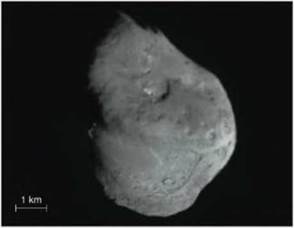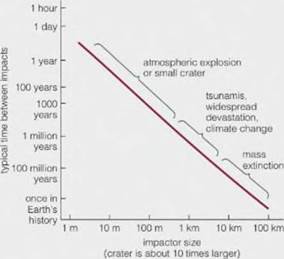
MODIFIED MAST ASTRONOMY:COSMIC PERSPECTI
9th Edition
ISBN: 9780136904496
Author: Bennett
Publisher: PEARSON
expand_more
expand_more
format_list_bulleted
Textbook Question
Chapter 12, Problem 2VSC
Use the following questions to check your understanding of some of the many types of visual information used in astronomy. Rir additional practice, try the Chapter 12 Visual Quiz at MastetingAstninomy*1 2 3.


The graph above I Figure 12.30) shows how often impacts occur for objects of different sizes. The photo above shows Comet Tempel 1 moments before the Deep Impact spacecraft crashed into it.
- Meteor Crater m Arizona is about 1.2 kilometers across. According to the graph, about how big was the object that made this crater? (Note: Be sure to read tine axis labels carefully.)
- I meter
- 10 meters
- 100 meters
- 1 kilometer
- How often do objects big enough Io create craters like Meteor Crater impact Earth?
- once in Earth's history
- about once every ten thousand years
- about once every few million years
- about once every day, but most burn up in the atmosphere or land in the ocean
Expert Solution & Answer
Want to see the full answer?
Check out a sample textbook solution
Students have asked these similar questions
3
Set
ба
||Axl
49.32
6b
71
Ay
22
Magnitude of A
Angle of A
24.04
Angle of -A
22
54
155.96
° (pos Ax) 204.04
° (neg Ax) 335.96
°
(pos Ax)
° (neg Ax)
115.77
° (pos Ax) 295.77
° (pos Ax)
-39
81
208.78
° (neg Ax) 28.78
°
(neg Ax)
3AA . not sure what i am getting wrong
Chapter 12 Solutions
MODIFIED MAST ASTRONOMY:COSMIC PERSPECTI
Ch. 12 - Prob. 1VSCCh. 12 - Use the following questions to check your...Ch. 12 - Use the following questions to check your...Ch. 12 - Prob. 4VSCCh. 12 - Use the following questions to check your...Ch. 12 - 1. Briefly define asteroid. comet, dwarf planet,...Ch. 12 - Briefly describe asteroid sizes, shapes, masses,...Ch. 12 - 3. Distinguish between primitive meteorites and...Ch. 12 - 4. What do meteorites and spacecraft observations...Ch. 12 - Prob. 5EAP
Ch. 12 - Prob. 6EAPCh. 12 - Prob. 7EAPCh. 12 - How do we know the Kuiper belt and Oort cloud...Ch. 12 - Prob. 9EAPCh. 12 - Prob. 10EAPCh. 12 - Prob. 11EAPCh. 12 - Briefly describe the evidence suggesting that an...Ch. 12 - Prob. 13EAPCh. 12 - Prob. 14EAPCh. 12 - Prob. 15EAPCh. 12 - Prob. 16EAPCh. 12 - Prob. 17EAPCh. 12 - Prob. 18EAPCh. 12 - Prob. 19EAPCh. 12 - Prob. 20EAPCh. 12 - Prob. 21EAPCh. 12 - Prob. 22EAPCh. 12 - Prob. 23EAPCh. 12 - Prob. 24EAPCh. 12 - Choose the best answer to each of the following....Ch. 12 - Choose the best answer to each of the following....Ch. 12 - Choose the best answer to each of the following....Ch. 12 - Choose the best answer to each of the following....Ch. 12 - Choose the best answer to each of the following....Ch. 12 - Choose the best answer to each of the following....Ch. 12 - Choose the best answer to each of the following....Ch. 12 - Choose the best answer to each of the following....Ch. 12 - Choose the best answer to each of the following....Ch. 12 - Choose the best answer to each of the following....Ch. 12 - The Role of Jupiter. Suppose that Jupiter had...Ch. 12 - Prob. 41EAPCh. 12 - Prob. 42EAPCh. 12 - Comet Tails. Describe in your own words why comets...Ch. 12 - Prob. 44EAPCh. 12 - Adding Up Asteroids. It’s estimated that there are...Ch. 12 - Impact Energies. A relatively small impact crater...Ch. 12 - The “Near Miss” of Toutatis. The 5-kilometer...Ch. 12 - Prob. 50EAPCh. 12 - Comet Temperatures. Find the “no greenhouse”...Ch. 12 - Comet Dust Accumulation. A few hundred tons of...
Knowledge Booster
Learn more about
Need a deep-dive on the concept behind this application? Look no further. Learn more about this topic, physics and related others by exploring similar questions and additional content below.Similar questions
arrow_back_ios
SEE MORE QUESTIONS
arrow_forward_ios
Recommended textbooks for you
 Glencoe Physics: Principles and Problems, Student...PhysicsISBN:9780078807213Author:Paul W. ZitzewitzPublisher:Glencoe/McGraw-Hill
Glencoe Physics: Principles and Problems, Student...PhysicsISBN:9780078807213Author:Paul W. ZitzewitzPublisher:Glencoe/McGraw-Hill AstronomyPhysicsISBN:9781938168284Author:Andrew Fraknoi; David Morrison; Sidney C. WolffPublisher:OpenStax
AstronomyPhysicsISBN:9781938168284Author:Andrew Fraknoi; David Morrison; Sidney C. WolffPublisher:OpenStax Foundations of Astronomy (MindTap Course List)PhysicsISBN:9781337399920Author:Michael A. Seeds, Dana BackmanPublisher:Cengage Learning
Foundations of Astronomy (MindTap Course List)PhysicsISBN:9781337399920Author:Michael A. Seeds, Dana BackmanPublisher:Cengage Learning Stars and Galaxies (MindTap Course List)PhysicsISBN:9781337399944Author:Michael A. SeedsPublisher:Cengage Learning
Stars and Galaxies (MindTap Course List)PhysicsISBN:9781337399944Author:Michael A. SeedsPublisher:Cengage Learning Horizons: Exploring the Universe (MindTap Course ...PhysicsISBN:9781305960961Author:Michael A. Seeds, Dana BackmanPublisher:Cengage Learning
Horizons: Exploring the Universe (MindTap Course ...PhysicsISBN:9781305960961Author:Michael A. Seeds, Dana BackmanPublisher:Cengage Learning

Glencoe Physics: Principles and Problems, Student...
Physics
ISBN:9780078807213
Author:Paul W. Zitzewitz
Publisher:Glencoe/McGraw-Hill

Astronomy
Physics
ISBN:9781938168284
Author:Andrew Fraknoi; David Morrison; Sidney C. Wolff
Publisher:OpenStax

Foundations of Astronomy (MindTap Course List)
Physics
ISBN:9781337399920
Author:Michael A. Seeds, Dana Backman
Publisher:Cengage Learning

Stars and Galaxies (MindTap Course List)
Physics
ISBN:9781337399944
Author:Michael A. Seeds
Publisher:Cengage Learning

Horizons: Exploring the Universe (MindTap Course ...
Physics
ISBN:9781305960961
Author:Michael A. Seeds, Dana Backman
Publisher:Cengage Learning

Kepler's Three Laws Explained; Author: PhysicsHigh;https://www.youtube.com/watch?v=kyR6EO_RMKE;License: Standard YouTube License, CC-BY